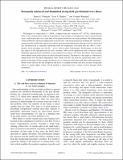| dc.contributor.author | Flanagan, Eanna E. | |
| dc.contributor.author | Ruangsri, Uchupol | |
| dc.contributor.author | Hughes, Scott A | |
| dc.date.accessioned | 2014-08-22T15:46:05Z | |
| dc.date.available | 2014-08-22T15:46:05Z | |
| dc.date.issued | 2014-04 | |
| dc.date.submitted | 2012-08 | |
| dc.identifier.issn | 1550-7998 | |
| dc.identifier.issn | 1550-2368 | |
| dc.identifier.uri | http://hdl.handle.net/1721.1/88979 | |
| dc.description.abstract | The inspiral of a stellar mass (1 − 100M[subscript ⊙]) compact body into a massive (10[superscript 5] − 10[superscript 7]M[subscript ⊙]) black hole has been a focus of much effort, both for the promise of such systems as astrophysical sources of gravitational waves, and because they are a clean limit of the general relativistic two-body problem. Our understanding of this problem has advanced significantly in recent years, with much progress in modeling the “self-force” arising from the small body’s interaction with its own spacetime deformation. Recent work has shown that this self-interaction is especially interesting when the frequencies associated with the orbit’s θ and r motions are in an integer ratio: Ω[subscript θ]/Ω[subscript r] = β[subscript θ]/β[subscript r], with β[subscript θ] and β[subscript r] both integers. In this paper, we show that key aspects of the self-interaction for such “resonant” orbits can be understood with a relatively simple Teukolsky-equation-based calculation of gravitational-wave fluxes. We show that fluxes from resonant orbits depend on the relative phase of radial and angular motions. The purpose of this paper is to illustrate in simple terms how this phase dependence arises using tools that are good for strong-field orbits, and to present a first study of how strongly the fluxes vary as a function of this phase and other orbital parameters. Future work will use the full dissipative self-force to examine resonant and near resonant strong-field effects in greater depth, which will be needed to characterize how a binary evolves through orbital resonances. | en_US |
| dc.description.sponsorship | National Science Foundation (U.S.) (Grant PHY-1068720) | en_US |
| dc.description.sponsorship | United States. National Aeronautics and Space Administration (Grant NNX08AL42G) | en_US |
| dc.language.iso | en_US | |
| dc.publisher | American Physical Society | en_US |
| dc.relation.isversionof | http://dx.doi.org/10.1103/PhysRevD.89.084028 | en_US |
| dc.rights | Article is made available in accordance with the publisher's policy and may be subject to US copyright law. Please refer to the publisher's site for terms of use. | en_US |
| dc.source | American Physical Society | en_US |
| dc.title | Resonantly enhanced and diminished strong-field gravitational-wave fluxes | en_US |
| dc.type | Article | en_US |
| dc.identifier.citation | Flanagan, Eanna E., Scott A. Hughes, and Uchupol Ruangsri. "Resonantly enhanced and diminished strong-field gravitational-wave fluxes." Phys. Rev. D 89, 084028 (April 2014). © 2014 American Physical Society | en_US |
| dc.contributor.department | Massachusetts Institute of Technology. Department of Physics | en_US |
| dc.contributor.department | MIT Kavli Institute for Astrophysics and Space Research | en_US |
| dc.contributor.mitauthor | Hughes, Scott A. | en_US |
| dc.contributor.mitauthor | Ruangsri, Uchupol | en_US |
| dc.relation.journal | Physical Review D | en_US |
| dc.eprint.version | Final published version | en_US |
| dc.type.uri | http://purl.org/eprint/type/JournalArticle | en_US |
| eprint.status | http://purl.org/eprint/status/PeerReviewed | en_US |
| dspace.orderedauthors | Flanagan, Eanna E.; Hughes, Scott A.; Ruangsri, Uchupol | en_US |
| dc.identifier.orcid | https://orcid.org/0000-0001-6211-1388 | |
| dc.identifier.orcid | https://orcid.org/0000-0001-5490-2227 | |
| mit.license | PUBLISHER_POLICY | en_US |
| mit.metadata.status | Complete | |
